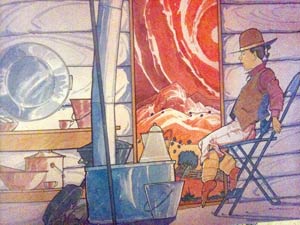Experts: Eclipse a good test of cultural relevance
CHINLE, May 17, 2012

(Courtesy of Baje Whitethorne)
This illustration from Baje Whitethorne's children's book "Sunpainters: Eclipse of the Navajo Sun" shows his protagonist, Kii Leonard, obeying his grandfather's orders to stay indoors while the red light of an impending eclipse can be seen through the hogan door.
People hurried to corral their livestock, ran inside, woke up sleeping relatives, built a fire and prayed.
No food was consumed, and even the livestock were prevented from eating or drinking, as it could contaminate their flesh and make them unfit for human consumption when they were eventually slaughtered.
When an annular solar eclipse is visible from the Navajo Nation Sunday, May 20, "it will be interesting to see how many people still observe the old ways," said Johnson, now the cultural specialist at the Navajo Nation Museum. "I doubt there are many."
If only a minority of Navajos observe what was one of the strictest taboos in the old religion, "I'm afraid our culture is already gone," Johnson said.
One person who plans to stay indoors Sunday evening is Kelly Francis, an apprentice chanter who is also a cultural specialist for the Navajo Nation Historic Preservation Department.
"If I don't stay in, I'll have to have a sand painting, body markings, all those things," he said.
Traditional diagnosticians blame everything from headaches to mental problems to blindness on exposure to an eclipse ... or even one's mother being exposed.
"If a baby was always bloated or had heartburn, they would say the mother nursed it during an eclipse," Johnson said.
Even sleeping during an eclipse can bring on health problems, in the Navajo way.
Johnson himself is a cautionary tale. He and his brother once snuck outside to watch an eclipse, and when he got older, he started to have problems with his eyes, he said.
But Diné should observe the taboo not out of fear but out of respect, Francis advised.
According to the Diné creation story, he explained, the Sun-Bearer must ask for a life each day as payment for carrying the burning turquoise disc of the sun across the sky - that's why people die.
"Sometimes a life can't be forfeited for the sun's journey," he said. "The journey can't be completed, so the sun burns out."
To stay inside and pray during an eclipse is "just a really strong way of showing respect for the sun and the Sun-Bearer," Francis said. "In our belief, the more you respect the Holy People, the more connection you will have with them and the more they will share with you."
Two generations ago, Francis said, Diné would go inside even during a rainstorm, for that was when the Holy People were about.
"I remember my grandmother telling me her father would wake her up if it started raining at 2 a.m., and they would stay up through the rainstorm instead of sleeping," he recalled.
(Of course, unlike rainstorms, eclipses are dangerous even for non-traditional folk. Watching one even for a few seconds can damage the retinas.)
Francis said there is "definitely" a message for the Navajo Nation in the fact that the sun will be directly over the Navajo Nation when it is eclipsed.
"To find out what the message is, for yourself or for the nation, you would have to consult a crystal gazer, a star gazer or a hand trembler," he said. "They would have to perform a ceremony."
Johnson said there is probably also some spiritual significance to the fact that the eclipse falls within the same month as the May 5 "super moon."
"I'm not a medicine man, but I would guess that, with the moon being a female entity and the sun male, the message has something to do with the male and female energy ... what the Asians would call the yin and yang," Johnson said.
"I hope the medicine man associations are meeting and discussing what this means."
The Times was unable to contact anyone in either the Diné Hataali Association or the Medicine Man Association.
If you're not traditional and want to watch the eclipse Sunday evening, doctors suggest the only safe way to do it is by projecting it through a pinhole onto a piece of white cardboard, looking through two layers of fully exposed black-and-white film, or with a professionally made solar filter.
Both El Morro National Monument and Chaco Culture National Historic Park (which was home to an ancient sun-worshipping culture) will be hosting eclipse-viewing events with safe viewing apparatus.
An annular, or ring-like, solar eclipse of the type that will be visible Sunday occurs when the moon passes between the earth and the sun, leaving only a spectacular ring of fire visible around its outer edge.
In the Four Corners, the eclipse should be visible in the western sky starting around 6:28 p.m. It will be at its maximum at 7:36 p.m. That's when you'll either want to be outside with your solar filter, or - like Johnson and Francis - inside praying.
By Cindy Yurth
Tséyi' Bureau

